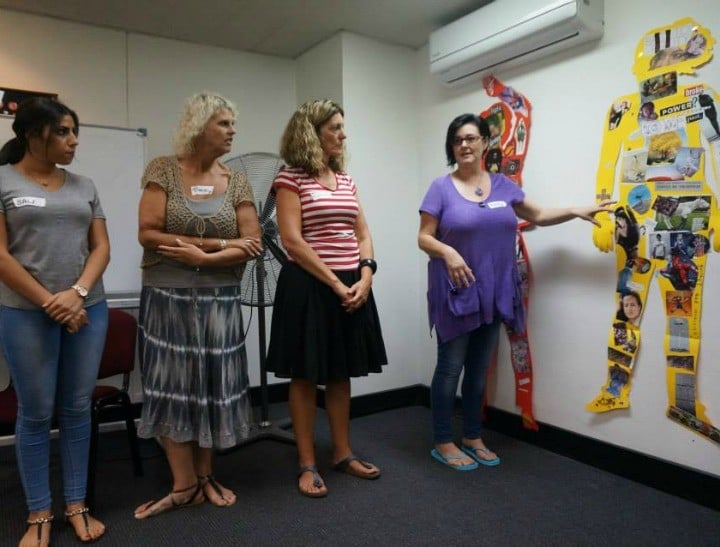It’s a hidden world we rarely think about, let alone imagine ever entering.
Shows like Wentworth and Orange is the New Black have attracted huge audiences by depicting life in a women’s prison, but are they accurate?
Consider this: Did you know the headphones you use on flights may have been wound and packaged by a woman in prison?
Or that the telemarketer you just spoke to may have called you from inside a NSW women’s correctional facility?
No? Me neither.
Those are just two of the jobs offered to inmates in the state’s women’s prisons, according to Kat Armstrong the founder of WIPAN, which stands for the Women in Prison Advocacy Network.
Armstrong knows about life on the inside – because she lived it.
A former heroin addict, she was incarcerated for crimes she committed to support her addiction.
This week, she joined Sarah Macdonald and Rebecca Huntley on the on the Debrief Daily “Just Between Us” to talk about her advocacy in that role and bust some myths about prison life for women.
It’s eye opening. You can listen and below on Soundcloud
We all know that popular television shows about women’s prisons, like Wentworth and Orange is the New Black, greatly exaggerate certain aspects of what goes on, but there are one or two things they do get right.
For example, the women are resourceful – especially when it comes to personal care.
“I’ve seen a couple of episodes of Orange is the New Black,” Armstrong says.
“Quite a lot of it, I believe, is sensationalised and some things are similar, but most of it is not the reality of what actually occurs in there on a day-to-day basis.

“Some of the the things [that are similar include] how resourceful the women become in doing things for themselves, because you just lose everything. So the things that they use to do beauty treatments and make-up and those sorts of things, they can become quite creative and quite inventive.”
Those who are lucky enough to have money (or relatives on the outside with money) can buy the basics, such as foundation, mascara, lipstick and rouge, but the most women inside simply don’t have the resources.
“They might use their oat cereal that they would use as their breakfast cereal as a face mask,” she explains.
“So they would mix that up with milk or water and make a paste and then use that as a face mask.
“If you are working out in the gardens of the prison you get sunscreen, so a lot of the women will use that sunscreen as a moisturiser for the rest of their bodies.”

Those without money going in earn a nominal wage from work programs. According to Armstrong, in NSW the amount ranges from $13 and $70 a week
It has to cover everything: shampoo, conditioner, soap, toothbrush and any extras like chocolate or a kettle.
“That’s what you have to survive on.”
And the jobs aren’t exactly stimulating (winding headphone, anyone?).
Armstrong believes boredom and the lack of education programs for women in correctional facilities is “the biggest issue.”
“Empowerment, education, jobs and training is the answer and giving a person a second chance so that they can successfully transition into the community and becoming functioning member of the community,” she says.

If a woman in prison chooses to opt for full time education, the wage she earns will fall somewhere in the realm of $25 a week – not a great incentive.
The female prison population is one of the fastest growing in Australia, and the majority of female prisoners come from deeply disadvantaged backgrounds; 98 per cent report a history of childhood and adult sexual, emotional or physical abuse.
They are more likely to have poor mental and physical health than men, and have higher rates of substance abuse.
“You have a lot of women who have significant trauma, significant drug addiction issues and significant mental health problems all just thrown in together,” Armstrong says.
“Can you imagine the dynamics and the situation of that?”
It’s especially difficult for women who aren’t incarcerated for drug or alcohol related offences who are then forced to share a cell for 16-18 hours a day with someone who is, for example, coming down from a drug like ice.
“I went to prison. I was a heroin addict so I committed crime to support my addiction. But heroin addiction and coming down off heroin is very different from speed or ice, cocaine, alcohol, and the psychosis that women experience as a result of withdrawing from drugs like that is majorly significant.”

That’s not to say that women don’t make friends, though – or form romantic attachments.
“I could give you five names right now … of women I met when I was in prison and who will be my lifelong friends until the day I die,” she says.
Gay relationships were widely accepted (both by prisoners and guards) but often don’t last once women are released, she said.
They usually begin “out of the necessity, for comfort and companionship more so than the sexual need,” she says, “because as human beings all we want is to be loved, nurtured and accepted.”
She also answered the ‘period question’.
“You put a lot of women together, within a couple of months all the women are menstruating the same time – and some women get serious PMT.
“Quite honestly, women can be dead-set bitches.”
You can find out more about WIPAN on their website or keep up to dat their Facebook .



 DEBRIEF DAILY
DEBRIEF DAILY